Shipping damages nearly one in ten packages. A multi-layered defense system is the industry standard for protecting your high-value acrylic displays. This system uses four core layers: surface protection, shock-absorbing cushioning, structural reinforcement, and a durable outer container. Proper packaging protects displays and safeguards your investment. It also protects your brand's reputation.
Did You Know? 💡 49% of consumers believe packaging should reflect a brand’s values.
Surface Protection for a Flawless Finish
The first layer of defense for your acrylic displays is surface protection. This step is critical. It prevents scratches, scuffs, and smudges that can ruin a product's finish before it even reaches the client. Proper surface packaging protects displays from contaminants like dust and fingerprints. You ensure your units arrive with a pristine, factory-fresh appearance.
Applying Low-Tack Protective Film
You should apply a low-tack protective film directly onto the acrylic surface. This film acts as a temporary skin. It shields the display during handling and transit. The film peels off easily without leaving adhesive residue. Different films offer various levels of thickness and UV resistance.
Pro Tip: Avoid Air Bubbles 🫧 A clean surface is essential for a bubble-free application.
First, clean the display and remove any static-attracting dust.
Wipe the edges to clear away debris from cutting.
Apply the film starting from one end. Use a squeegee or your hand to smooth it down, pushing air out as you go.
Choosing the right film depends on your specific needs, from short-term handling to long-term storage with UV exposure.
Property | Example 1 | Example 2 |
|---|---|---|
Material | Polyethylene (PE) | BOPET (Matte) |
Thickness | ||
Adhesion | 4 oz/in | 1-2N/25mm (Ultra-Low) |
UV Resistance | 30 days | 6-12 months |
Wrapping with Non-Abrasive Foam
After applying the film, you wrap the entire display in non-abrasive foam. This second skin provides an extra layer of cushioning. The material is typically made from low-density polyethylene (LDPE). It has a closed-cell structure, making it soft, lightweight, and resistant to moisture. This foam wrap prevents any friction or abrasion from other packaging materials inside the box. It is a simple yet effective way to preserve the flawless finish of your custom and retail-specific units.
Shock-Absorbing Cushioning

Once you protect the surface, the next layer of defense is shock-absorbing cushioning. This layer absorbs impacts, vibrations, and g-forces during transit. Proper cushioning is how effective packaging protects displays from drops and rough handling. It creates a protective void around your product, ensuring it remains stationary and safe.
Choosing Dense vs. Molded Foam
You must select the right foam to match your display's weight and fragility. Your choice will determine how well the unit is braced and immobilized.
Polyethylene (PE) Foam: Use dense PE foam for blocking and bracing heavy displays. This material has densities ranging from one to nine pounds per cubic foot (pcf). Its firmness prevents heavy items from shifting. You can cut PE planks to create a sturdy frame that holds the display securely in place.
Expanded Polystyrene (EPS) Foam: Choose EPS for cost-effective, custom-molded inserts. EPS is extremely lightweight—about 98% air—which helps lower shipping costs. You can mold it into precise shapes that nest your display perfectly, preventing any movement. This method can reduce damage rates by up to 40% by creating a custom-fit environment for complex or multi-part units.
Using the 'Floating' Method
The 'floating' method is an industry-standard technique for isolating your product from external shock. You create a cushioned buffer that allows the display to "float" inside its outer container. This system uses the foam's structure to absorb and dissipate energy from impacts.
Rule of Thumb: The Two-Inch Zone 📏 You should maintain a minimum of two inches of cushioning between the display and the interior box walls. This space is critical. It ensures that any force from a drop or collision is absorbed by the foam before it reaches your product.
This method is essential for protecting items with low g-factors, like sensitive electronic displays that are vulnerable to g-forces. By creating this protective gap, you isolate the display from harmful vibrations and impacts. This simple step is a key part of how packaging protects displays, ensuring they arrive in perfect working order.
Reinforcing Vulnerable Edges and Corners
Your display's edges and corners are its most vulnerable points. Impacts to these areas can cause cracks, chips, and structural failure. You can add a crucial layer of structural integrity by reinforcing these weak spots. This step ensures your package can withstand the pressures of stacking and handling during transit.
Using Corner and Edge Protectors
You should apply corner and edge protectors to shield your display from direct impact. These protectors also dramatically increase the stacking strength of your boxes. They transfer the stress of a stacked load to the container's edges, creating a stronger frame. This reinforcement protects against damage from forklifts and clamp trucks. You have several material options for this purpose:
Laminated Paperboard: This material, often made from recycled paper, is formed into rigid shapes like VBoard or UChannels. It is ideal for protecting the edges of flat items like tabletops or glass panels.
Polyethylene (Plastic): You can use plastic protectors for heavy-duty applications or in high-moisture environments. They offer excellent durability and weather resistance.
Moisture-Resistant Composites: Some protectors combine paper and plastic. They provide strong protection for shipments exposed to the elements on flatbed trucks or in humid climates.
Bracing Complex or Multi-Part Displays
Complex or multi-part displays require internal bracing to prevent components from shifting. You must immobilize every piece to avoid collisions inside the box. Effective bracing combines two distinct techniques.
Pro Tip: Blocking vs. Bracing 🧱
Blocking prevents your display from moving side-to-side or front-to-back.
Bracing stops your display from moving up and down. You need both. Bracing keeps the load from jumping over the blocks, ensuring total stability.
You can achieve a secure fit with custom inserts designed for your product's unique shape. These inserts act as a perfect cradle, holding everything in place. Common options include molded paper pulp, custom-cut foam inserts, and die-cut corrugated pieces. These solutions fill empty space and provide structural support, ensuring all parts of your display arrive without damage.
How Outer Packaging Protects Displays

The final layer of defense is the outer container. This exterior shell shields your display from punctures, compression, and environmental hazards. Your choice of box or crate is the primary barrier between your product and the rigors of the supply chain. Proper outer packaging protects displays by providing a durable, structurally sound enclosure.
Selecting the Right Box or Crate
You should select an outer container based on your display's size, weight, and shipping destination. For most domestic shipments, corrugated boxes are the standard.
Double-Walled or Triple-Walled Boxes: You need to use these boxes for their superior puncture resistance and stacking strength. A box's durability is measured by its burst strength, or the pressure it can withstand before rupturing. Triple-walled boxes offer significantly higher resistance, making them essential for heavy or fragile units.
ISPM 15 Certified Wooden Crates: For very large, heavy, or high-value international shipments, you must use wooden crates. These crates must be ISPM 15 certified to prevent the spread of pests. This involves heat-treating (HT) the wood and stamping it with an official IPPC mark. Failure to comply can lead to customs rejecting, destroying, or forcing the repackaging of your shipment at your expense.
Sealing and Labeling for Transit
Properly sealing and labeling your container communicates its handling needs and ensures its integrity. This final step is critical for a successful delivery.
Pro Tip: Use the H-Tape Method 📦 You can create a secure seal by applying packaging tape to form an 'H' on the top and bottom of the box. First, tape the center seam where the major flaps meet. Then, tape along the two edge seams. This method reinforces all potential weak points.
You must also apply clear handling instructions. Use universally recognized international pictograms to overcome language barriers.
Pictogram | Meaning |
|---|---|
Cracked Wine Glass | Fragile, handle with care. |
Two Upward Arrows | Keep this side up. |
Hands Cupping a Box | Handle with care. |
For sea freight, you need to combat moisture. Place desiccant packs inside the container to absorb humidity and prevent damage. The quantity you need depends on container volume, transit time, and climate. Finally, place the main shipping label on the package’s largest surface. Ensure it is flat and away from any seams to guarantee scannability.
You can ensure damage-free shipping with a simple checklist.
Protect Surfaces
Cushion for Shock
Reinforce Corners
Use a Durable Outer Container
This robust strategy is a direct investment in your profitability. Better packaging protects displays and can increase revenue. Adopt this system to build your reputation. You will gain customer loyalty, as 52% of customers repurchase from brands that use premium packaging.
FAQ
How do I package an unusually shaped display?
You should use custom-molded inserts made from materials like EPS foam or paper pulp. These inserts create a perfect cradle for your display's unique shape. This method immobilizes the product, prevents internal movement, and provides superior protection against shock during transit.
Can I reuse packaging for my displays?
You can reuse durable components like wooden crates and PE foam blocks. Inspect them for any wear or damage before each use. You should always replace single-use items like corrugated boxes, protective film, and sealing tape to ensure maximum protection for every shipment.
What is the most common packaging mistake? 🧐
The most common mistake is leaving empty space inside the box. Voids allow your product to shift and collide with the container walls, causing damage. You must fill all empty space with appropriate cushioning or bracing materials to ensure your display remains secure.
Which packaging tape is best for heavy boxes?
You need a strong, pressure-sensitive tape for heavy boxes. Water-activated tape (WAT) creates a powerful bond with corrugated surfaces. For standard pressure-sensitive tape, choose one with a thickness of at least 2.5 mil for reliable adhesion and strength on heavier shipments.

